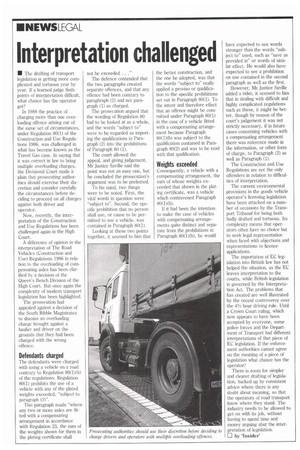Interpretation challenged
Page 22

If you've noticed an error in this article please click here to report it so we can fix it.
• The drafting of transport legislation is getting more complicated and tortuous year by year. If a learned judge finds points of interpretation difficult, what chance has the operator got?
In 1988 the practice of charging more than one overloading offence arising out of the same set of circumstances, under Regulation 80(1) of the Construction and Use Regulations 1986, was challenged in what has become known as the Travel Gas case. In saying that it was correct in law to bring multiple overloading charges, the Divisional Court made it plain that prosecuting authorities should exercise their discretion and consider carefully the circumstances before deciding to proceed on all charges against both driver and operator.
Now, recently, the interpretation of the Construction and Use Regulations has been challenged again in the High Court.
A difference of opinion in the interpretation of The Road Vehicles (Construction and Use) Regulations 1986 in relation to the overloading of compensating axles has been clarified by a decision of the Queen's Bench Division of the High Court. But once again the complexity of modern transport legislation has been highlighted.
The prosecution had appealed against a decision of the South Ribble Magistrates to dismiss an overloading charge brought against a haulier and driver on the grounds that they had been charged with the wrong offence.
Defendants charged
The defendants were charged with using a vehicle on a road contrary to Regulation 80(1)(b) of the regulations. Regulation 80(1) prohibits the use of a vehicle with any of the plated weights exceeded, "subject to paragraph (2)".
This paragraph reads "where any two or more axles are fitted with a compensating arrangement in accordance with Regulation 23, the sum of the weights shown for them in the plating certificate shall not be exceeded. ."
The defence contended that the two paragraphs created separate offences, and that any offence had been contrary to paraghraph (2) and not paragraph (1) as charged.
The prosecution argued that the wording of Regulation 80 had to be looked at as a whole, and the words "subject to" were to be regarded as importing the qualifications in Paragraph (2) into the prohibitions of Paragraph 80 (1).
The court allowed the appeal, and giving judgement, Mr Justice Saville said the point was not an easy one, but he concluded the prosecution's argument was to be preferred.
To his mind, two things were to be noted. First, the vital words in question were "subject to". Second, the specific prohibition that no person shall use, or cause to be permitted to use a vehicle, was contained in Paragraph 80(1).
Looking at these two points together, it seemed to him that
the better construction, and the one he adopted, was that the words "subject to" really applied a proviso or qualification to the specific prohibitions set out in Paragraph 80(1). To the intent and therefore effect that an offence might be committed under Paragraph 80(1) in the case of a vehicle fitted with a compensating arrangement because Paragraph 80(1)(b) was subject to the qualification contained in Paragraph 80(2) and was to be read with that qualification.
Weights exceeded
Consequently, a vehicle with a compensating arrangement, the sum of whose weights exceeded that shown in the plating certificate, was a vehicle which contravened Paragraph 80(1)(b).
If it had been the intention, to make the case of vehicles with compensating arrangements quite distinct and separate from the prohibitions in Paragraph 80(1)(b), he would
have expected to see words stronger than the words "subject to" used, such as "save as provided in" or words of similar effect. He would also have expected to see a prohibition on use contained in the second paragraph as well as the first.
However, Mr Justice Saville added a rider, it seemed to him that in dealing with difficult and highly complicated regulations such as these, it might be better, though by reason of the court's judgement it was not strictly necessary, if in future cases concerning vehicles with a compensating arrangement there was reference made in the information, or other form of charge, to Paragraph (2) as well as Paragraph (1).
The Construction and Use Regulations are not the only offenders in relation to difficulties of interpretation.
The current environmental provisions in the goods vehicle operator's licensing legislation have been attacked on a number of occasions by the Transport Tribunal for being both badly drafted and tortuous. Its complexity means that operators often have no choice but to seek legal representation when faced with objections and representations to licence applications.
The importation of EC legislation into British law has not helped the situation, as the EC leaves interpretation to the courts, while British legislation is governed by the Interpretation Act. The problems that has created are well illustrated by the recent controversy over the 41/2 hour driving rule. Until a Crown Court ruling, which now appears to have been accepted by everyone, some police forces and the Department of Transport had different interpretations of that piece of EC legislation. If the enforcement authorities cannot agree on the meaning of a piece of legislation what chance has the operator?
There is room for simpler and clearer drafting of legislation, backed up by consistent advice where there is any doubt about meaning, so that the operators of road transport know where they stand. The industry needs to be allowed to get on with its job, without having to spend time and money arguing abut the interpretation of legislation.
by 'Insider'




































































































